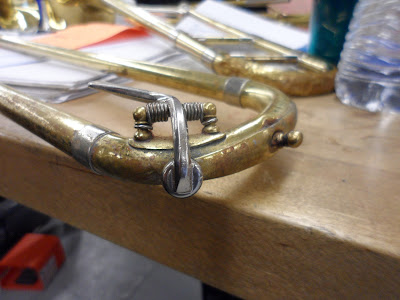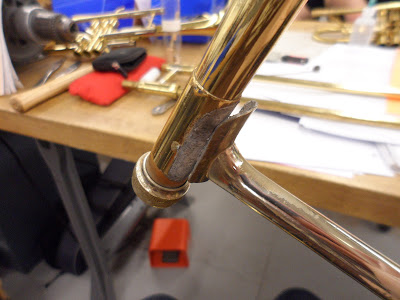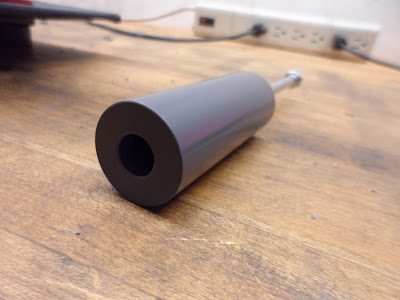Time to do a review. Taking out a bow dent, a buckle and some smaller dents.
Alright, a customer project! This one is exciting. The owner wants to add a waterkey to the third slide and a finger hook (saddle) to the first slide. The trumpet also has mysterious blowouts on the throat (this is what happens if you try to take out dents with a drumstick) and the bell flare needs to be finished off (it obviously had a buckle, but someone tried to take most of it out).
The first thing I noticed when I got the trumpet. A gig bag. This does not protect the trumpet very well, even if the padding is nice. Trumpets should be kept in hard cases with a nice "nest" for them to rest in.
That was a throat dent that is almost out, better finish that up nicer.
Alright, a bell bow dent. I did a similar dent in my practice bell just few days ago, so this will be easy to get out.
This is a wroth tool, it's kind of hard to see in this picture because of the Canadian included, but look at the tool that is stuck in the vice. It has a long rod and a ball on the end of it.
This is the end of the wroth tool. I put a dentball on it (and greased it up) and I will pass it through the bell, into the bell bow, where the dent is waiting for me. I start out with smaller dentballs, and do some tapping to get the ridges down, but otherwise it's just bigger and bigger dentballs being passed carefully through.
This is my trumpet on the wroth tool. The rod is handy to have easier access through the stem.
What complicated fancy tool is this to take out blowouts from the trumpet throat? It's curved to the right form and everything!
It's just a knife from the salvation army (10 cents) that I annealed (heated until red) and hit with a huge hammer over a mandrel to make it to the right curve so taking out the throat dents will be a breeze.
I took out the teeth of the knife first, so I wouldn't harm the trumpet.
Time for a lathe project! This time we are making a bearing seater, that will help us put some sort of metal shims back on a horn, I'm sure I'll understand that better once we get to the french horn.
The object is to make a hole for the screw (and threads) and make a big short hole on the other end, so the plastic can push down.
This is a mini lathe (not as scary as the big ones), it turns things really fast so we can shape them accordingly to what we want, or drill into them.
Yay, lathe. This me working on a mini lathe.
Drilling the hole for the screw.Keep in mind that the plastic part is spinning, not the drillbit.
Drilling the big hole!
This is the finished product, it looks pretty nice.
This is what the finished product looks like from the side.
Aligning the 3rd slide on a trumpet. It's supposed to run silky smooth without stop, so the player can easily move it while playing.
Aligning the first slide. This one is harder because it doesn't have a brace on it. Also the lower outer tube is out of round, so we'll have to deal with that before the slide will submit to our will.












































